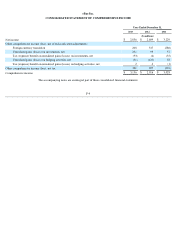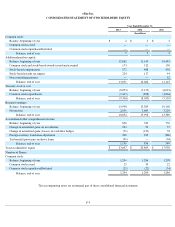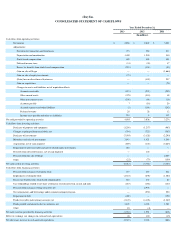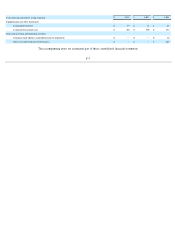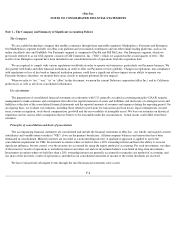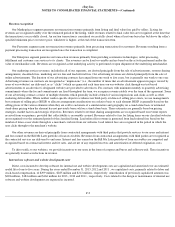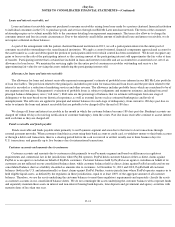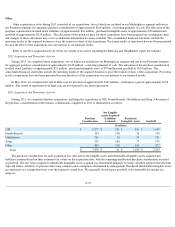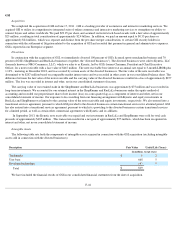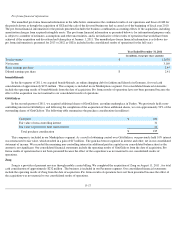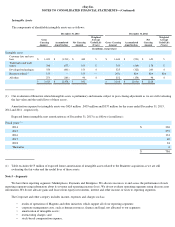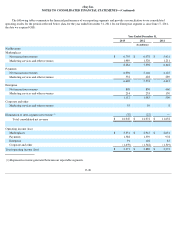eBay 2013 Annual Report Download - page 110
Download and view the complete annual report
Please find page 110 of the 2013 eBay annual report below. You can navigate through the pages in the report by either clicking on the pages listed below, or by using the keyword search tool below to find specific information within the annual report.
eBay Inc.
NOTES TO CONSOLIDATED FINANCIAL STATEMENTS—(Continued)
Foreign currency
Most of our foreign subsidiaries use the local currency of their respective countries as their functional currency. Assets and liabilities are
translated at exchange rates prevailing at the balance sheet dates. Revenues, costs and expenses are translated into U.S. dollars using daily
exchange rates if the transaction is recorded in our accounting systems on a daily basis, and otherwise using average exchange rates for the
period. Gains and losses resulting from the translation of our consolidated balance sheet are recorded as a component of accumulated other
comprehensive income.
Gains and losses from foreign currency transactions are recognized as interest and other, net.
Derivative instruments
We have significant international revenues as well as costs denominated in foreign currencies, subjecting us to foreign currency risk. We
enter into foreign currency exchange contracts that qualify as cash flow hedges, generally with maturities of 18 months or less, to reduce the
volatility of cash flows related primarily to forecasted revenue and intercompany transactions denominated in certain foreign currencies. All
outstanding derivatives are recognized on the balance sheet at fair value. The effective portion of the designated derivative's gain or loss is
initially reported as a component of accumulated other comprehensive income and is subsequently reclassified into the financial statement line
item in which the hedged item is recorded in the same period the forecasted transaction affects earnings.
We also economically hedge our exposure to foreign currency denominated monetary assets and liabilities with foreign currency contracts.
The gains and losses on the foreign exchange contracts economically offset transaction gains and losses on certain foreign currency denominated
monetary assets and liabilities recognized in earnings. Accordingly, these outstanding non-designated derivatives are recognized on the balance
sheet at fair value and changes in fair value from these contracts are recorded in interest and other, net in the consolidated statement of income.
Our derivatives program is not designed or operated for speculative purposes.
Our derivative instruments expose us to credit risk to the extent that our counterparties may be unable to meet the terms of the agreements.
We seek to mitigate this risk by limiting our counterparties to major financial institutions and by spreading the risk across several major financial
institutions. In addition, the potential risk of loss with any one counterparty resulting from this type of credit risk is monitored on an ongoing
basis. See “Note 8 - Derivative Instruments” for additional information related to our derivative instruments.
Concentration of credit risk
Our cash, cash equivalents, accounts receivable, loans and interest receivable, funds receivable and customer accounts are potentially
subject to concentration of credit risk. Cash, cash equivalents and customer accounts are placed with financial institutions that management
believes are of high credit quality. In addition, funds receivable are generated with financial institutions or credit card companies that
management believes are of high credit quality. Our accounts receivable are derived from revenue earned from customers located in the U.S. and
internationally. Our loans and interest receivable are derived from consumer financing activities for customers located in the U.S. As of
December 31, 2013 and 2012 , no customer accounted for more than 10% of net loans and interest receivable. In each of the years ended
December 31, 2013, 2012 and 2011 , no customer accounted for more than 10% of net revenues.
Recent Accounting Pronouncements
In 2013, the Financial Accounting Standards Board ("FASB") issued new accounting guidance clarifying the accounting for the release of a
cumulative translation adjustment into net income when a parent either sells a part or all of its investment in a foreign entity or no longer holds a
controlling financial interest in a subsidiary or group of assets that is a nonprofit activity or a business within a foreign entity. The new standard
is effective for fiscal years, and interim periods within those fiscal years, beginning on or after December 15, 2013. We do not anticipate that this
adoption will have a significant impact on our financial position, results of operations, or cash flows.
In 2013, the FASB issued new accounting guidance clarifying the accounting for obligations resulting from joint and several liability
arrangements for which the total amount under the arrangement is fixed at the reporting date. The new standard is effective for fiscal years, and
interim periods within those fiscal years, beginning on or after December 15, 2013. We do not anticipate that this adoption will have a significant
impact on our financial position, results of operations, or cash flows.
F-13


